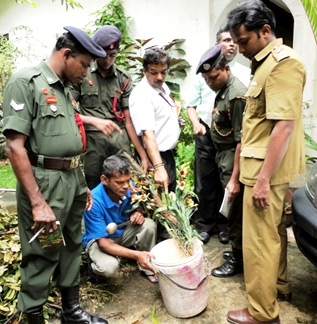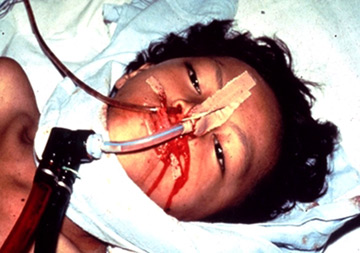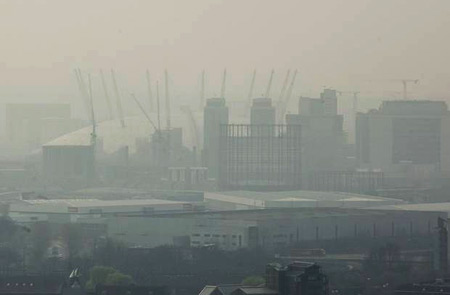|

Dengue control is in your hands
By Carol Aloysius
Dengue is rapidly reaching epidemic levels with the number of
suspected cases mounting each day. To control its spread, the Health
Ministry has launched a special Dengue Control program next week with
hundreds of health officials and Public Health Inspectors visiting
houses in an attempt to minimise the number of breeding sites which have
largely contributed to the spread of dengue.
Chief Medical Officer Dehiwela - Mt Lavinia Dr Indika Ellawala
discusses how dengue spreads, its symptoms and most importantly how one
can prevent its complications leading to death.
Excerpts…
Q: What is dengue?
|

Health Inspectors look for dengue vector larvae among plants |
A: It is an infection caused by a virus. The virus is transmitted by
Aedes aegypti and Aedes albopictus mosquitoes. There are 4 subtypes of
the virus: DEN 1, DEN 2, DEN 3, DEN4. Therefore a human can contract
Dengue fever four times during the life time.
Q: What is a dengue mosquito?
A: It’s a very active small black mosquito. The female Aedes mosquito
is the vector of dengue. It bites several people to get one blood meal.
It bites mainly during the mornings and evenings.
Q: What is the life span of this mosquito?
A: The life span of an adult Aedes mosquito is around 2-4 weeks.
During that period it lays eggs around four times – with 100- 200 eggs
at a time. The eggs are sticky and thus difficult to remove.
Q: How long does it take for an adult mosquito to lay its eggs?
A: Around 7-11 days.
Q: For how long can these eggs remain live?
A: Eggs can remain live up to one year in dry conditions and hatch on
contact with water
Q: Who are the groups most vulnerable to getting dengue?
A: The risk groups are as follows:
1. Children: Because the Aedes mosquitoes are day bitters, school
going children are more vulnerable to get infected with dengue virus.
2. Elders, since their immune system has weakened.
3. Obese people
4. Persons with chronic diseases (e.g. Bronchial asthma, diabetes)
5. Persons with immunodeficiency.
Q: What are the symptoms that indicate a person is infected with the
dengue virus?
A: Around 90 percent of people infected with the dengue virus for the
first time do not show symptoms and signs. But they too have dengue
virus in their blood for 5-7 days.
During this period if they are bitten by mosquitoes, the virus can
enter into these mosquitoes with the blood meal and multiply within the
mosquitoes.
These infected mosquitoes can then transmit the virus to healthy
people. So you may have already contracted dengue fever for the first
time with or without your knowledge.
Q: Once the virus enters the body, how long does it take for symptoms
to present?
A: Between 7-10 days to develop symptoms and signs.
If a person is infected with one subtype of dengue virus, antibodies
are formed against that subtype and he/she will be protected for that
particular virus subtype in the future, but not protected for remaining
three subtypes.
Therefore they can contract dengue fever again by any of other three
subtypes of virus.
When a person contracts dengue fever for the 2nd, 3rd, or 4th time,
the disease is more severe than first episode, and the possibility of
developing Dengue Haemorrhagic Fever (DHF) is high.
Q: You mentioned DHF. Are there other types of dengue as well?
If you have fever…
· Suspect
it as dengue fever
·
Take adequate rest
·
Avoid sending children to schools, adults should not to
go work
· Exempt
from strenuous exercise/work
·
Take only Paracetamol in recommended doses for fever
· Avoid
other fever reducing drugs in any form (tablets, syrups,
suppositories etc) such as Diclofenac Sodium, Mefenemic
Acid, Aspirin and Ibuprofen
·
If fever continues for more than two
days, consult a qualified doctor.
·
Drink adequate amount of liquids (oral rehydration
fluid-Jeewani, king coconut water, other fruit juices,
kanji, soup)
· Avoid
taking red/brown colour foods or drinks which can change
the colour of stools/urine |
|
|

A young victim of Dengue Haemorrhagic Fever |
A: Many patients infected with dengue virus remain asymptomatic.
Others can develop a febrile illness one of the following types:
·Undifferentiated fever
·Dengue Fever (DF)
·Dengue Haemorrhagic Fever (DHF) - most serious
Q: How does dengue progress to its most severe form (DHF)?
A: It goes through the following phases:
1. Fever phase
2.Critical (Leakage) phase
3. Convalescent
(Recovery) phase
Fever phase
Fever phase usually lasts 2-7 days.’ During fever phase the patient
can have body aches and pain, muscle pain ,severe headache, pain behind
the eyes, vomiting and rash (Red Colour). Sometimes there can be sore
throat and congestion of eyes (red eyes).
These symptoms are similar in both dengue fever and dengue
haemorrhagic fever.
Sometimes the fever can subside abruptly, but the patient’s condition
deteriorates and goes into complications of dengue fever.
Therefore monitoring of patient’s general condition, adequate rest
and fluid intake will be helpful to prevent complications.
Critical phase
The critical phase is usually evident after three days of fever and
the symptoms and signs are due to plasma (liquid part of the blood)
leakage through blood vessels due to the adverse effects of the virus on
walls of blood vessels. This will cause thickening of blood and
circulatory failure leading to shock. Due to the same reason, there is
reduction of blood supply to essential organs in the body causing
failure of vital organs.
Patient can die of either of these complications or by both.
Q: How can you prevent a patient going into this critical phase?
A: Early detection and prompt treatments can prevent death. Reduction
of platelets is usually not a reason for death in dengue patients.
Convalescent (Recovery) phase
During recovery phase, plasma which leaked out of the blood vessels
will re-enter the blood stream and patient’s condition improves
gradually.
Regaining appetite and improvement of urine output are some
indicators of recovery. During this phase too it is necessary to take
adequate rest and food.
Q: What are the early suspected symptoms of dengue?
A: Watch out for the presence of the following clinical features with
acute onset of fever.
Headache and retro-orbital pain.
Joint pain (Arthralgia) and muscle pain (myalgia)
Rash
Laboratory findings
· Low white cell counts (Leucopenia - WBC 5000/mm3)
· Low platelet count (?150,000/ mm3)
· Rising Haematocrit (HCT- 5-10 percent)
Q: Can dengue be managed at home?
A: It can be managed at home by adhering to the following guidelines:
Carers must ensure the patient gets adequate oral fluid intake (oral
rehydration fluid, king coconut water, other fruit juices, kanji, soup).
Avoid red and brown drinks
* Adequate physical rest
* Tepid sponging for fever
* Paracetamol (10-15mg/kg/dose - Do not exceed 60mg/kg/24 hours)
* Anti-emetics if necessary.
* Avoid other analgesics in any form and steroids.
* Review daily with Full Blood Count (FBC)
* First FBC should be done on the third day of fever and daily
thereafter if the platelet count is 150,000/mm3; twice daily if
150,000/mm3).
However, a FBC is recommended on the first day of fever during
infancy and in patients with major medical problems
Warning signs
·Inability to tolerate oral fluids
·Refuse to eat or drink
·Feeling extremely thirsty
·Severe abdominal pain/ vomiting
·Cold and clammy extremities
·Bleeding manifestations
·Not passing urine for more than six hours
·Behavioural changes: Confusion, restlessness, lethargy, irritability
Criteria for admission
·All patients with a platelet count of ?100,000/ mm3
·All patients with above mentioned warning signs
Infants, obese patients, patients with major medical problems,
patients with adverse social circumstances (living alone, living far
from health care facility without reliable transport, unreliable
patients also should be admitted.
b) Hospital
Mortality from dengue can be reduced by timely management.
Appropriate clinical management, which involves early clinical and
laboratory diagnosis, intravenous rehydration and staff training.
Q: Can dengue be prevented with vaccines?
A: A vaccine against dengue fever is in the process of being
developed.
Q: As the Chief Medical Officer of two high risk areas what steps are
you taking to control the spread of dengue in those areas?
A: We use chemical control. This can be effective in controlling the
mosquito population.
Insecticides can be used to kill mosquito larvae or adult mosquitoes.
The use of insecticides is recommended in emergency situations during
dengue epidemics.
On a regular basis use of chemical methods can make mosquitoes to
develop resistance to insecticides.
In addition, insecticides are expensive and harmful to humans when
using high doses. Mosquito repellents which contain DEET, Picaridin or
oil of lemon/eucalyptus.
We also advise residents to take the following precautions:
·Avoid being bitten by mosquitoes
-Keep unscreened windows closed
One practical and recommended environmental management strategy is to
eliminate unnecessary breeding habitats that collect water (plastic
jars, bottles, cans, tyres) in which Aedes aegypti mosquito can lay the
eggs. This strategy is called ‘source reduction’.
Q: Some people prefer to rely on traditional medicines offered by
native physicians to cure dengue. Your comments?
A: Many native physicians promise overnight cure for dengue.
But there is no scientific basis for these medicines. These
medications can worsen the scenario.
My advice is to get treatment and advice from a qualified medical
practitioner who will handle each case according to the latest National
Guidelines for Dengue management.
Q: Your message to the public?
A: Action at community level is an effective method of reducing
mosquito breeding sites. But for communities to understand the need to
make behavioural changes, they should be educated about mosquito vectors
and the risk of having mosquito breeding habitats near their houses.
As all of us are at risk in dengue virus infection, please pay
attention to roof gutters because 20 percent of breeding places are
found in those sites.
Comments
We have noticed that in more than 75 percent dengue cases, the source
of infection is inside their premises and people still believe that this
source reduction exercise has to be carried out by health officials.
People have to realise that regular cleaning of their premises is their
own responsibility.
To some extent the law enforcement also has helped reduce the dengue
cases.
Air pollution linked to autism and schizophrenia
A new study has revealed that exposure to air pollution damages the
brain of developing mice, affecting the same area of the brain that is
known to play a role in autism and schizophrenia in humans.
|

A view of the Arena through smog on April 2, 2014, when dust
from the Sahara combined with pollution from mainland Europe to
create one of the worst smogs of the year. |
Researchers from the University of Rochester in the US found that
when mice were regularly exposed to fine particle pollution in the first
two weeks of their life, they developed a range of brain abnormalities
which are consistent with patterns seen in humans suffering from
schizophrenia and autism.
These harmful effects were mainly observed in the male mice; a
finding that corresponds to the fact that boys and men are more likely
to be diagnosed with both of these disorders.
“Our findings add to the growing body of evidence that air pollution
may play a role in autism, as well as in other neuro-developmental
disorders,” said Deborah Cory-Slechta, professor of Environmental
Medicine at the University of Rochester and lead author of the study,
published in the journal Environmental Health Perspectives.
Exposure to fine particle air pollution was found to cause
inflammation in the brains of the young mice, damaging the development
of white matter. The lateral ventricles, cavities in the brain which are
filled with cerebrospinal fluid and protect the brain from trauma, were
found to be enlarged to up to three times their normal size, filling up
the free space in the underdeveloped brains.
This dilation of the ventricles has previously been linked to autism
and schizophrenia in humans. In addition, after breathing the
contaminated air, the male mice exhibited a high level of glutamate in
the brain, a neurotransmitter found to be abnormally high in individuals
suffering from these same two conditions.
The air pollution created in the lab by Cory-Slechta and her
colleagues matches the level typically present during rush hour in a
medium-sized US city. The mice were exposed to the impure air for four
hours a day during four days of their first week of life, followed by a
further four days during the second week after birth. Developmentally,
these timings correspond to the period just before and just after birth
in human babies.
The study focused on the ultra-fine particles in polluted air,
believed by the researchers to be more detrimental to health than their
larger counterparts, which can be filtered out by the nose and lungs.
Although most previous research on the adverse health effects of
pollution has focused on the consequences for the respiratory system and
heart function, earlier studies have linked airborne pollutants to other
neuro-developmental problems, including cognitive decline and
depression.
The new findings correspond with a recent study by researchers at the
University of Southern California and the University of California, in
which children who spent their first year of life in areas with high
levels of air pollution were found to be three times as likely to
develop autism than those starting out in cleaner surroundings.
Currently, an estimated one percent of people in the UK could be
affected by a disorder on the autistic spectrum.
The prevalence of autism is growing, and researchers are keen to
understand the reasons behind what some describe as an “autism
epidemic”. Earlier this month a report emerged linking the condition to
higher levels of testosterone in the womb.
Schizophrenia affects a similar number of people, and, like autism,
its causes are far from being fully understood.
According to Cory-Slechta, her discovery does not necessarily mean
that pollution is responsible for causing autism or schizophreniA: “I
never use the word ‘causes,'” she told USA Today.
“I try to make people understand it's the interaction of all these
risk factors in your life, over your lifespan, that come together.”
However, she does believe that changes in regulation should be
considered: “I think these findings are going to raise new questions
about whether the current regulatory standards for air quality are
sufficient to protect our children”.
-The Independent |

